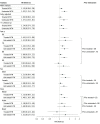Use of Antihypertensives, Blood Pressure, and Estimated Risk of Dementia in Late Life: An Individual Participant Data Meta-Analysis
- PMID: 37698858
- PMCID: PMC10498335
- DOI: 10.1001/jamanetworkopen.2023.33353
Use of Antihypertensives, Blood Pressure, and Estimated Risk of Dementia in Late Life: An Individual Participant Data Meta-Analysis
Abstract
Importance: The utility of antihypertensives and ideal blood pressure (BP) for dementia prevention in late life remains unclear and highly contested.
Objectives: To assess the associations of hypertension history, antihypertensive use, and baseline measured BP in late life (age >60 years) with dementia and the moderating factors of age, sex, and racial group.
Data source and study selection: Longitudinal, population-based studies of aging participating in the Cohort Studies of Memory in an International Consortium (COSMIC) group were included. Participants were individuals without dementia at baseline aged 60 to 110 years and were based in 15 different countries (US, Brazil, Australia, China, Korea, Singapore, Central African Republic, Republic of Congo, Nigeria, Germany, Spain, Italy, France, Sweden, and Greece).
Data extraction and synthesis: Participants were grouped in 3 categories based on previous diagnosis of hypertension and baseline antihypertensive use: healthy controls, treated hypertension, and untreated hypertension. Baseline systolic BP (SBP) and diastolic BP (DBP) were treated as continuous variables. Reporting followed the Preferred Reporting Items for Systematic Review and Meta-Analyses of Individual Participant Data reporting guidelines.
Main outcomes and measures: The key outcome was all-cause dementia. Mixed-effects Cox proportional hazards models were used to assess the associations between the exposures and the key outcome variable. The association between dementia and baseline BP was modeled using nonlinear natural splines. The main analysis was a partially adjusted Cox proportional hazards model controlling for age, age squared, sex, education, racial group, and a random effect for study. Sensitivity analyses included a fully adjusted analysis, a restricted analysis of those individuals with more than 5 years of follow-up data, and models examining the moderating factors of age, sex, and racial group.
Results: The analysis included 17 studies with 34 519 community dwelling older adults (20 160 [58.4%] female) with a mean (SD) age of 72.5 (7.5) years and a mean (SD) follow-up of 4.3 (4.3) years. In the main, partially adjusted analysis including 14 studies, individuals with untreated hypertension had a 42% increased risk of dementia compared with healthy controls (hazard ratio [HR], 1.42; 95% CI 1.15-1.76; P = .001) and 26% increased risk compared with individuals with treated hypertension (HR, 1.26; 95% CI, 1.03-1.53; P = .02). Individuals with treated hypertension had no significant increased dementia risk compared with healthy controls (HR, 1.13; 95% CI, 0.99-1.28; P = .07). The association of antihypertensive use or hypertension status with dementia did not vary with baseline BP. There was no significant association of baseline SBP or DBP with dementia risk in any of the analyses. There were no significant interactions with age, sex, or racial group for any of the analyses.
Conclusions and relevance: This individual patient data meta-analysis of longitudinal cohort studies found that antihypertensive use was associated with decreased dementia risk compared with individuals with untreated hypertension through all ages in late life. Individuals with treated hypertension had no increased risk of dementia compared with healthy controls.
Conflict of interest statement
Figures


References
Publication types
MeSH terms
Substances
Grants and funding
LinkOut - more resources
Full Text Sources
Medical

